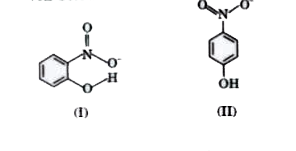Which species can form intermolecular hydrogen bonds with other molecules or ions of the same type?
(P) HF
(Q) CH3F
(R) NH+4
P only
R only
P and R only
P, Q and R
The correct Answer is:A
NH+4 does not have lone pair.
Topper's Solved these Questions
- CHEMICAL BONDING-IBook:GRB PUBLICATIONChapter:CHEMICAL BONDING-IExercise:H. Oxyacids, Naming of Inorganic Compounds, Important Structures
Explore 61 Videos
- CHEMICAL BONDING-IBook:GRB PUBLICATIONChapter:CHEMICAL BONDING-IExercise:I. Allotropy
Explore 13 Videos
- CHEMICAL BONDING-IBook:GRB PUBLICATIONChapter:CHEMICAL BONDING-IExercise:F.Resoncance
Explore 29 Videos
- CARBOXYLIC ACID AND DERIVATIVES, AMINES AND OTHER NITROGEN COMPOUNDSBook:GRB PUBLICATIONChapter:CARBOXYLIC ACID AND DERIVATIVES, AMINES AND OTHER NITROGEN COMPOUNDSExercise:Subjective type
Explore 19 Videos
- CHEMICAL KINETICSBook:GRB PUBLICATIONChapter:CHEMICAL KINETICSExercise:Subjective Type
Explore 63 Videos
Similar Questions
Why does NH4 form hydrogen bond but PH3 does not ?
View SolutionStructures of molecules of two compounds are given below :

(a) Which of the following compounds will have intermolecular hydrogen bonding and which compound is expected to show intramolecular hydrogen bonding?
(b) Which of the above two compounds will show higher melting point?
(c ) Which of the above compounds will form hydrogen bond with water easily and be more soluble in it?
View Solution
Knowledge Check
Which of the following can form intermolecular H-bonding between its molecules?
ACH3OCH3BCH3COCH3CCH3ClDN2H4Which pure compounds form intermolecular hydrogen bonds?
(P) HF
(Q) H2S
(R) CH4AP onlyBR onlyCP and Q onlyDQ and R onlyIn Which of the following compound are intermolecular hydrogen bonds not formed among its molecules .
ACH3CH2NH2B(CH3CH2)2NHC(CH3CH2)3NDBoth (2) and (3)
Read the given passage and answer questions number 1 to 5 that follow :
The lower aliphatic amines are gases with fishy odour. Primary amines with three or more carbon atoms are liquid and still higher one are solid. Aniline and other arylamines are usually colourless but get coloured on storage due to atmospheric oxidation. Lower aliphatic amines are soluble in water because they can form hydrogen bonds with water molecules. However, solubility decreases with increase in molar mass of amines due to increase in size of the hydrophobic alkyl part. Higher amines are essentially insoluble in water. Considering the electronegativity of nitrogen of amine and oxygen of alcohols in water. Out of butan-1-ol and butan-1-amine, which will be more soluble in water and why? Amines are soluble in organic solvents like alcohol, ether and benzene. You may remember that alcohols are more polar than amines and form stronger intermolecular hydrogen bonds than amines. Primary and secondary amines are engaged in intermolecular association due to hydrogen bonding between nitrogen of one and hydrogen of another molecule. This intermolecular association is more in primary amines than in secondary amines as there are two hydrogen atoms available for hydrogen bond formation in it. Tertiary amines do not have intermolecular association due to the absence of hydrogen atom available for hydrogen bond formation. Therefore, the order of boiling points of isomeric amines is as follows :
Primary > Secondary > Tertiary.
Arrange the following compounds in increasing order of boiling point :
CH3−CH2−CH∣CH3−NH2,CH3−CH3∣C∣CH3−NH2,CH3CH2CH2CH2NH2
View SolutionWhich of the following organic molecule can not form hydrogen bond in pure state but can form the same in water?
View SolutionChoose the molecules in which hybridization occurs in the ground state?
(P) BCl3
(Q) NH3
(R) PCl3
(S) BeF2
View SolutionAssertion :The orystal sturctures of NaHCO3 and KHCO3 both show intermolecule hydrogen bonding but are different.
Reason :In NaHCO3 the HCO3 ions are linked togather through intermolecular hydrogen bond into an inflate chain white in KHCO3HCO−3 ions form dimerics anions through intermolecular hydrogen bonds.
View SolutionPure samples of which of the following exhibit hydrogen bonding?
(P) CH3OH
(Q) CH3NO2
(R) CH3CN
View Solution

